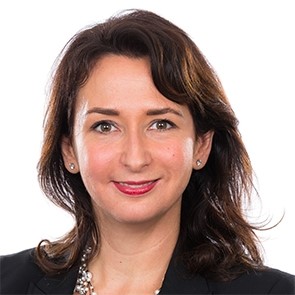03 June, 2015
ETNO ThinkDigital interview – International Law firm Pinsent Masons’ Diane Mullenex on achieving the degree of super-connectivity that the world demands.
Diane Mullenex, French lawyer and UK Solicitor: “Regulation in my view, must not inhibit investment or innovation in the development and deployment of high-speed networks to achieve the degrees of super-connectivity that the world demands” #ThinkDigital

In a recent speech (March 2015), Vice-President Ansip said “We cannot have a Digital Single Market without the necessary backbone of telecommunications”. What is your advice to regulators and legislators who are working hard to redefine rules and encourage investment in the necessary high-speed networks that will underpin Europe’s Digital Economy?
Firstly, I agree with VP Ansip’s comment. The difficulty, as I think we all know in this industry, is how to best deliver this ‘backbone’ and under what type of regulatory environment. The question is how much or how little regulation is required. Unsurprisingly, this is a topic everyone is talking about, especially given the pace of change of technology itself, together with the consumer desire and demand to be super-connected at every level of daily life. The question affects consumers, operators, investors and regulators alike and it is perhaps the regulators who will receive the most scrutiny as to how they address the need for change and innovation, protect consumers and ensure access via robust but balanced regulation going forward.
It is true, in my view, that there is much inconsistency between the telecoms legislative frameworks across the EU. This makes expanding the necessary telecoms infrastructure cumbersome and expensive for investors and operators alike. Connectivity – be it terrestrial, wireless or satellite - is the engine for the digital age. For this reason, it needs to be simultaneously supported by incentives to infrastructure investment and consistent regulation. I think convergence between these two factors in the digital marketplace is essential to ensure that future regulations deliver this super connectivity and leave space for innovation.
EU reforms, particularly the Digital Single Market regulation, are driving convergence and consolidation in the market on nearly every level. I consider that consistency in regulation across countries will only enhance and foster innovation and investment, which are both essential. The efforts of the Digital Single Market regulation, the Telecom Single Market regulation (the ‘Connected Continent’ package) and other EU proposed reforms are a brave attempt to overcome the significant diversity between national regulations and promote consistency across the EU. Presently however, given the extensive inconsistency in regulation across Europe, I wonder if this series of EU reforms will really bring about the needed change anytime soon. I fear this may not be the case in the short term a least.
Tension between free-market competition and regulated provision continues and remains difficult to reconcile. This is particularly so in the mobile market for example, where regulators see the need for more regulation to ensure coverage, access and availability to consumers. However, as the telecoms infrastructure has itself almost become a ‘utility’, it remains to be seen if this means greater or lesser degrees of regulation. Either way, regulation in my view, must not inhibit investment or innovation in the development and deployment of high-speed networks to achieve the degrees of super-connectivity that the world demands.
To be fair, regulators are faced with addressing a vast number of complex issues and conflicting stakeholder interests in a race they cannot win. The winner, I believe, will always be the pace of technological change. Innovation and investment are key, and regulators must, in my view, be very cognisant of this in formulating the next generation of regulation.
Consumer behaviour and business models have changed dramatically since the beginning of this century. What impact has this had on market dynamics and how should policymakers adapt rules to the new landscape?
The improvement of networks and the increase of content accessibility have indeed led to the rise of popular VoIP or OTT services, requiring an ever-increasing network capacity to support the traffic generated by those services.
Although operators have built networks to respond to consumer demands, they are currently facing a situation in which they are unable to make a fair return on their investments in networks. The current regulatory framework, which limits the possibility for operators to make a fair return on investment (by limiting wholesale prices to network access), has subsequently limited the potential for continuous investment in new and upgraded networks.
This regulatory landscape results in a situation in which (i) operators do not have flexibility to upgrade their infrastructure and (ii) there are increasing territorial disparities in terms of network access and bandwidth.
In terms of Net Neutrality, which is currently being debated at European as well as international level, this is a situation that needs urgent scrutiny by policy makers. The objective of ensuring an equal treatment of traffic to the benefit of customers can only be achieved if operators benefit from the required flexibility to finance their networks in a profitable manner.
The EU institutions are currently discussing a reform of the spectrum management framework. Considering that spectrum is the lifeblood of mobile communications and is a scarce resource, what do you think should be the main focus of this reform?
There is currently a debate in the EU stemming from the adoption of the Regulation on the European single market for electronic communications which aims in particular at implementing a spectrum management framework. Indeed, the demand for mobile internet traffic in Europe is estimated to increase more than ten times from 2014 to 2019 and as the demand for spectrum is higher than the availability, there is a need for its management.
In this respect, any reform should establish a clear framework determining attribution rules depending on the intended use of the spectrum. Indeed, each band of spectrum has specific characteristics and their use should be optimised to meet needs for new services such as video or VoIP. For example, lower frequencies have several advantages such as better penetration and propagating further and therefore require less infrastructure. In this respect, Germany was the first European country to decide to auction for telecommunications' use, those frequencies that were used for television. Such a coordinated repartition of spectrum within the EU would be a tremendous medium to achieve a single Digital Market and would have the added advantage of allowing operators to adopt a pan European strategy regarding traffic management measures. This "segregation" of services by spectrum range may further help operators to ensure that traffic is treated equally, as per the latest proposals of the EU on Net Neutrality.
Finally, harmonising the conditions, timing and duration for licences could act as an incentive for investors who will then be able to better anticipate their costs and revenues.
As the Council finalises the Telecom Single Market Regulation, what approach would you advise Member States to take when it comes to ensuring an Open Internet, while safeguarding healthy and innovative markets?
Debates on Open Internet and Net Neutrality are very contentious and the subject of much discussion at an international and particularly, EU level at present. It is not an easy question to answer simply. In my view, the Member States should strive for a regulation that recognises and encourages the existing dynamic competitive environment and enables future innovation rather than throttling it, enabling stakeholders to have points of differentiation in service offerings to encourage competition and innovation. The Member States should maintain a consumer/end-user focus, ensuring real choice and transparency of service offerings, as well as enhanced access and levels of QoS and effective and enforceable prohibitions and enforcement mechanisms to make a ‘real’ difference. I hope they formulate regulation that is simple, logical, technology-agnostic and that may be applied without contentious, time-consuming and uncertain judicial interpretations (and re-interpretations).
Addressing these principles must be done sensibly to settle the regulation in a good place. By this I mean leaving room for positive free-market practices to develop the future of the internet, to foster innovation and investment together with a sensible form of regulation that will not starve the market or its development.
As with all these issues, for regulators and stakeholders alike, there is no one silver bullet or one size fits all that the Member States can rely upon to both nurture and inspire innovation and competition on the one hand and regulate to protect and to enshrine fundamental values and rights on the other. But I sincerely believe it’s worth giving it a very good try!
By ETNO #ThinkDigital, Brussels, 3 June 2015
***
Diane Mullenex, French lawyer and UK Solicitor, Pinsent Masons
Diane Mullenex's biography can be found here.


